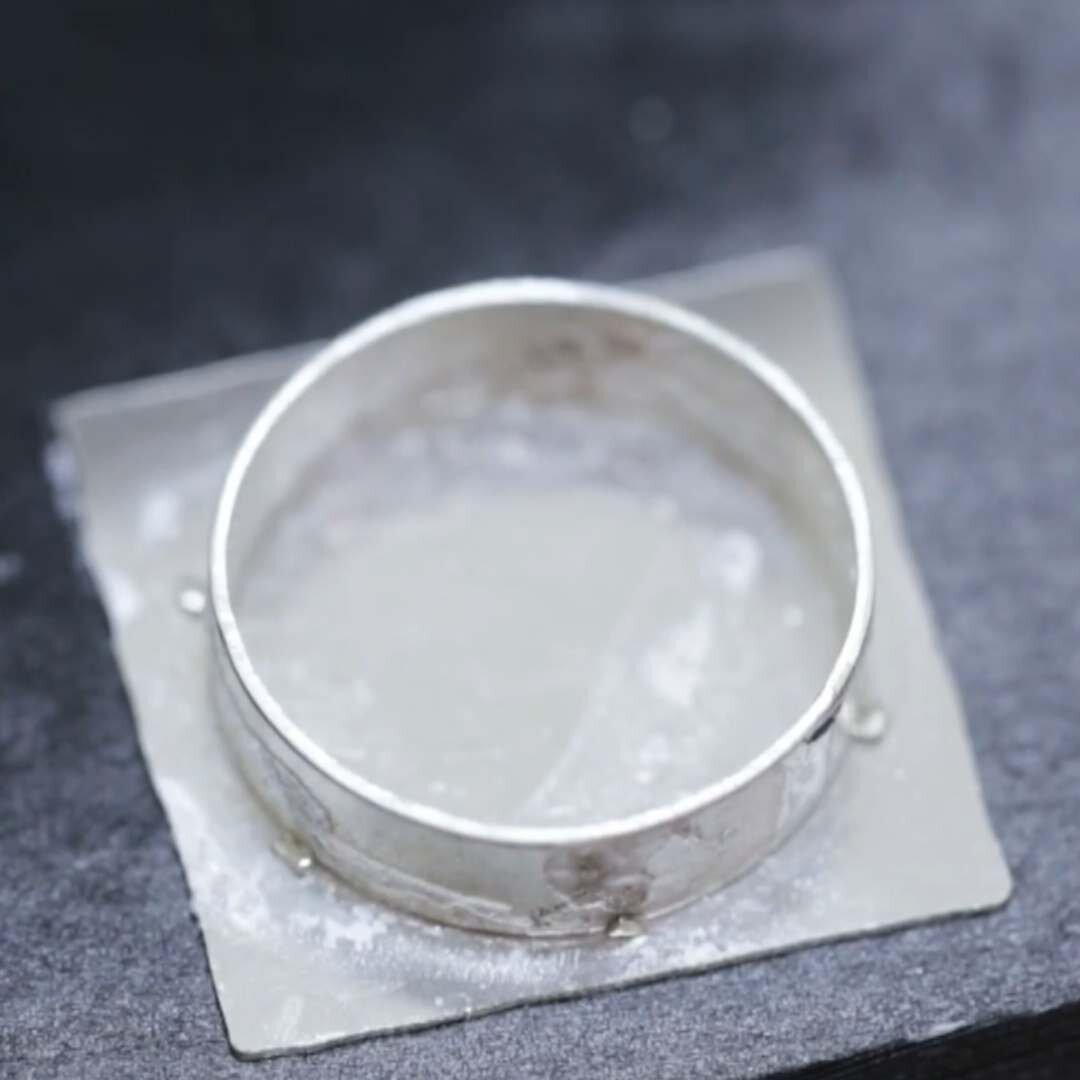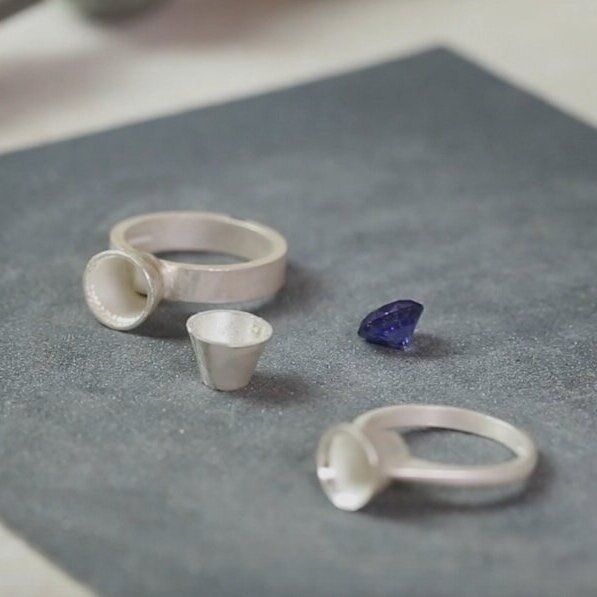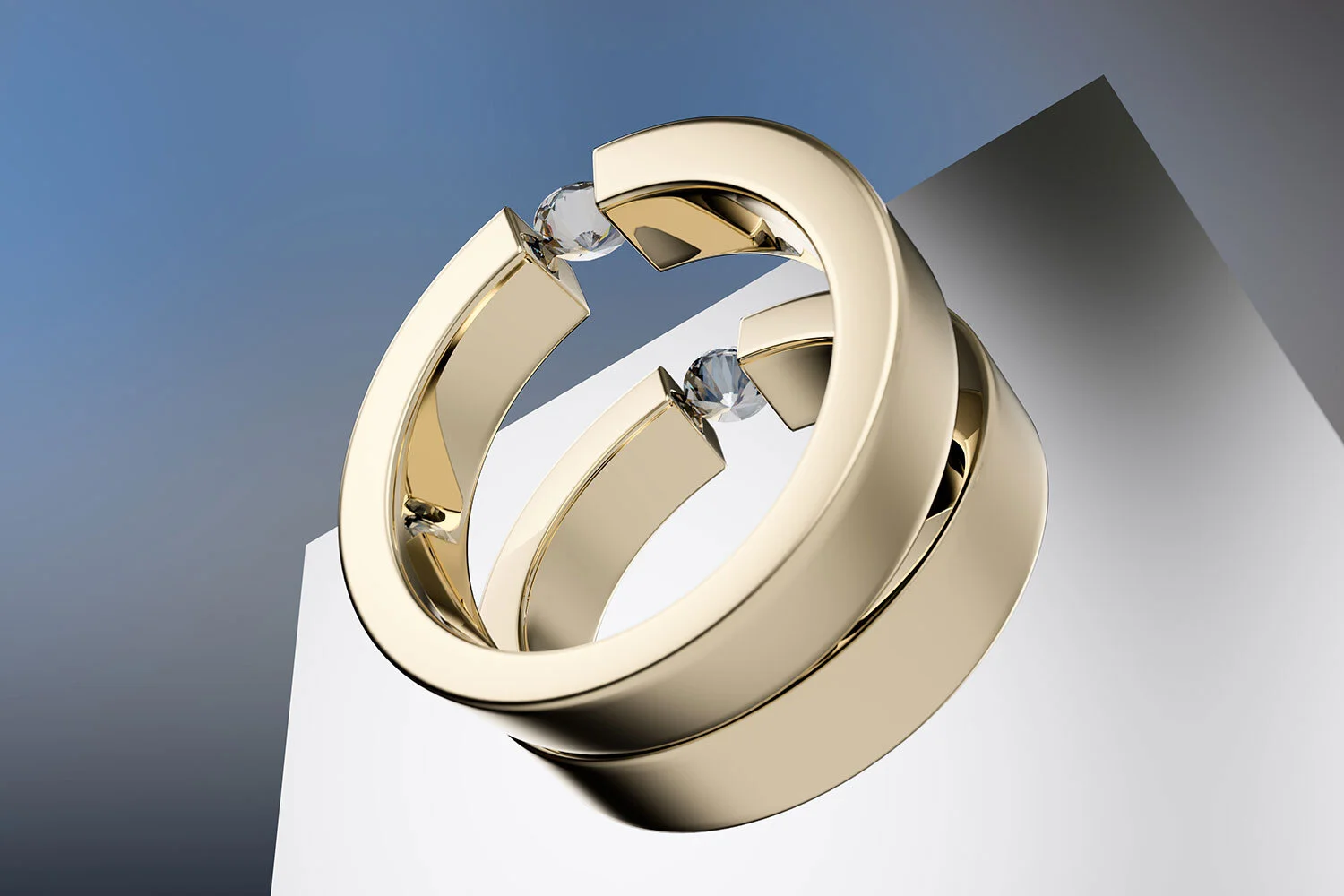Gemstone Settings for your handmade Jewellery Designs
Blog
Do you want to start adding gemstones to your jewellery designs?
Or maybe you have one or two stone setting techniques you use time and time again, but you want to advance your skills so you can expand your design possibilities?
But it can be hard to know where to start. So this blog covers 12 of the main gemstone setting types so you get an overview of all the possibilities for your jewellery designs.
1. CABOCHON (RUBOVER OR BEZEL) SETTING
A cabochon setting is typically one of the first settings that you learn to make as a jeweller. You tend to start here as it is a great way to learn the fundamentals of fabricating settings and then setting the gemstones in terms of setting in a ‘North, South, East and West’ formation.
Also known as a rubover or bezel setting, it is best suited to flat-backed stones which either have a smooth, curved top, or a rose cut top (with chunky facets). It doesn’t matter if a cabochon is round, oval, square, pear shape or even an irregular shape, as long as it has a flat (or flattish) back, you can use this type of setting in your designs with cabochon stones.
You essentially create the setting using a silver (or gold) sheet baseplate, and a strip of bezel wire or fine silver strip (0.3mm or 0.5mm thick) that you then push over the gemstone to hold it in place.
2. TUBE (RUBOVER) Setting
Another type of gemstone setting that is usually learned early on when first learning how to set gemstones is the tube setting. It is similar to a bezel setting in that you rub the wall of the setting over the stone. But as you use prefabricated tubing to create these gemstones it is only really suitable for round gemstones. This type of setting can be used with both facetted (diamond shape) gemstones and cabochons. It is however more typically used with smaller, round diamond-cut gemstones.
The tube needs to be slightly wider than the stone you wish to set, and you cut the seat for the stone using a round or setting burr in a pin vice or a pendant motor to thin the bezel so the stone drops into the setting. You leave use enough of a lip of metal to gently push or rub the bezel wall over the stone’s girdle to hold in securely in place.
3. flush (gypsy) setting
Another popular setting type is called flush setting (also known as gypsy setting). This kind of setting is for small, round facetted gemstones or diamonds and is a lovely, modern way of adding a little bit of sparkle to your designs. The stone is set flush with the plane of the metal so almost becomes part of the metal. Similar to tube setting, you use a a round or setting burr to cut the seat for the stone, drop the stone in securely and then use a finger burnisher to gently bring the lip of the seat over the girdle of the stone to hold it in place.
The lovely thing about this type of setting is that it is very smooth and low profile so it doesn’t catch on clothing.
These three setting types alone can open up infinite possibilities design wise! If you want to get started on your stone setting journey and learn these setting types, we have some great online courses for you!
Our FREE Make a stone set ring using pre-made settings will teach you how to set your own stones on to a silver ring in a 30 minute tutorial with talented silversmith, Sophie Arnott.
Our comprehensive Stone Setting in Silver course taught by silversmith Rebecca Steiner takes you step by step how to learn three beautiful stone setting techniques: cabochon, tube and flush settings and is the perfect way to master this trio of stone setting techniques.
And if you want to learn to set fancy shaped cabochon gemstones, then our Intermediate Silver and Setting Shaped Cabochons course is a great option for you. In this course you will learn how to develop your stone setting skills to set beautiful shaped cabochon stones such as teardrops/ pear shaped, squares, rectangles and more in the stone setting course with Hayley Kruger.
4. COLLET SETTING
Once you have mastered the essential stone setting techniques you might want to try some of the more advanced setting fabrication and setting types. A nice progression is the collet setting. This setting is similar to tube setting, except instead of the walls of the setting being straight, the setting has a slight taper to it. It is an elegant setting that is perfect for engagement rings.
You can create round collet settings for smaller stones using tubing and using a tool called a collet block which has a series of divots where you place your tubing, and a special punch that helps you created the nice taper. For larger stones you can create the setting using sheet metal and finesse the shape using the collet block.
You can also create tapered collets in fancy shapes if you purchase fancy shaped collet blocks. These collet blocks are typically more expensive that round collet blocks, but are a worthwhile investment if you particularly want to create tapered fancy shape collets.
Collet blocks come in two forms - a 17 degree plate and punch which gives a slight taper to the setting, and a 28 degree plate and punch which gives a more exaggerate taper. It is a matter of preference which block you choose as both work in exactly the same way.
The great thing about learning how to create collet settings is that is such a flexible setting type that is easily adapted into other settings such as a claw or crown setting. Once you have created your tapered collet, you can adapt the setting using a saw and/ or needle files to create partial bezels and carve claws and decoration to create a traditional 6 prong crown settings.
5. CHANNEL SETTING
This is a lovely and sleek setting type to learn. It is one of the more advanced stone setting techniques, so you want to make sure you are confident with soldering and the more basic setting types before attempting channel setting. And with channel setting precision is the name of the game. You essentially carve a channel for the gemstones to sit in and is suitable for most shapes of facetted stones (although round and square gemstones are the most common shapes of gemstones used in this type of stone setting). Channel settings can look both traditional and modern depending on the design.
If you want to dip your toes into some more advanced techniques then our Stone Setting Bundle: Collet Setting and Channel Setting course is a great way to try these two fabulous techniques.
6. CLAW (BASKET) SETTING
If you want to start offering engagement or anniversary rings as part of your jewellery collections, you will soon want to learn how to create and set stones in claw (sometimes know as basket) settings. There are a variety of different types of claw settings including single and double gallery settings and it is a fabulous way to set facetted stones so that you get to see as much of the gemstone or diamond as possible. You primarily set facetted stones in claw settings but you can also set flat-backed cabochons with claws by adapting the technique slightly.
And if you want to advance your skills and learn how to fabricate claw settings from scratch then our Make an Engagement Ring (4 Claw Setting) course with goldsmith, Hayley Kruger is a great option where you will learn step-by-step how to create a four claw setting engagement ring.
The pieces below are made using pre-cast settings. This course is available exclusively in the Diploma in Silver Jewellery.
7. GRAIN (or bead) SETTING
If you want your designs to have a slightly vintage feel then grain settings might be a good option. Grain setting is a technique where diamonds (or other facetted gemstones) are set into the metal close together to give the impression of a band of stones, and a graver is used to create little beads that are pushed over the edges of the stone to hold it in place. Sometimes only a tiny amount of metal is pushed over the stone so you can barely see the setting.
This is an advanced technique but is really effective in giving a vintage feel when setting small facetted stones.
8. STAR SETTING
Star setting is one in which a gemstone is placed into the centre of a star that has been carved or engraved into the metal. The stone is held in place by small beads of metal at the base of each of the points. It is a traditional stone setting technique that is really making a comeback into jewellery designs. It is an advanced technique due to the precision and skills required and is included in the Diploma in Fine Jewellery.
9. PAVE SETTING
Another advanced technique that requires specialist optical magnifiers to set lots tiny stones placed close together into the metal. Pave is a setting that consists of a lot of small gemstones set into the metal by tiny prongs or beads, creating the appearance of a line of continuous small diamonds or gemstones. As a result, the surface of the piece with such a setting looks like it has been paved with diamonds or other stones, hence the name of this setting. This setting type gives a very sparkly look. There is also micro pave which is extremely tiny diamonds set together. Pave setting takes years to master and is best done by an experienced setter for the best results.
Pave setting is taught by Master Stone Setter Scott McIntyre in our Advanced Jewellery Diploma.
10. WAX CARVED STONE SETTINGS
Now traditionally stone settings have been fabricated from metal sheet and wire. But the more modern technique of waxing carving offers a different way of creating stone settings (particularly the more tricky fancy shape ones). You use wax carving tools to carve the setting to fit round your chosen gemstone. You can either get the gemstones cast directly into the metal similar to Polly Wales’s stunning jewellery, or you can have the piece cast into your chosen metal, and then set the stone afterwards similar to regular stone setting.
If you fancy learning how to carve stone settings in wax, do have a look at our Stone Setting in Wax online course with Sophie Arnott. You will learn how to carve settings for both facetted stones and cabochons.
11. HAMMERED BEZEL
One of the latest trends in stone setting is a textured or hammered bezel. This is where of getting setting the stone with a smooth bezel, you use a punch (or a foredom hammer handpick) to create little divots in the bezel that pushes the metal around the stone. A beautifully organic and rustic setting.
12. TENSION SETTING
The final setting type on our list is a tension setting. This is where the gemstone is held in place using the tension in the metal ring. It is a very modern, sleek and minimalist setting style.
Tension setting is taught by Master Stone Setter Scott McIntyre in our Advanced Jewellery Diploma.
So that is our top 12 list of gemstone setting types! Which one is next on your list to learn how to do?
Do share your stone setting makes with us using the hashtag #jewellersacademy on Instagram. We would love to see them!
And don’t forget, if you want to develop your stone setting skills then we are here for you with lots of amazing stone setting courses (and more coming soon!). Here are some of our stone setting courses to get you started:
Beginner:
Our FREE Make a stone set ring using pre-made settings teaches you how to use pre-made bezel cups to set stones.
Our comprehensive Stone Setting in Silver course cover cabochon, tube and flush settings and is the perfect way to master this trio of stone setting techniques.
Intermediate:
Our Intermediate Silver and Setting Shaped Cabochons covers how to set beautiful shaped cabochon stones such as teardrops/ pear-shaped, squares, rectangles and more.
Our FREE Introduction to Claw Setting course covers how to create your own prong/basket/claw setting to showcase your gorgeous gemstone designs.
Advanced:
Our Stone Setting Bundle: Collet Setting and Channel Setting course is a great way to try these two more advanced stone setting techniques.
And for those who want to make engagement rings then Make an Engagement Ring (4 Claw Setting) course is a great introduction to claw setting.
And for those who prefer to create designs in wax then our Stone Setting in Wax online course is a comprehensive introduction to learning to carve settings for cabochon and facetted stones.
And Stone Setting & Soldering using Cast Settings online course where you learn to create three stone, trilogy anniversary and engagement rings.
Which stone setting course is on your wish list? Tell us in the comments below!
Like the idea of a step by step approach to starting a business? Take a look at our course Launch Your Jewellery Business in 20 Days
Get a task for your jewellery business sent to you every day for 20 days. Use it as a checklist, help spread out the work and get started!

























